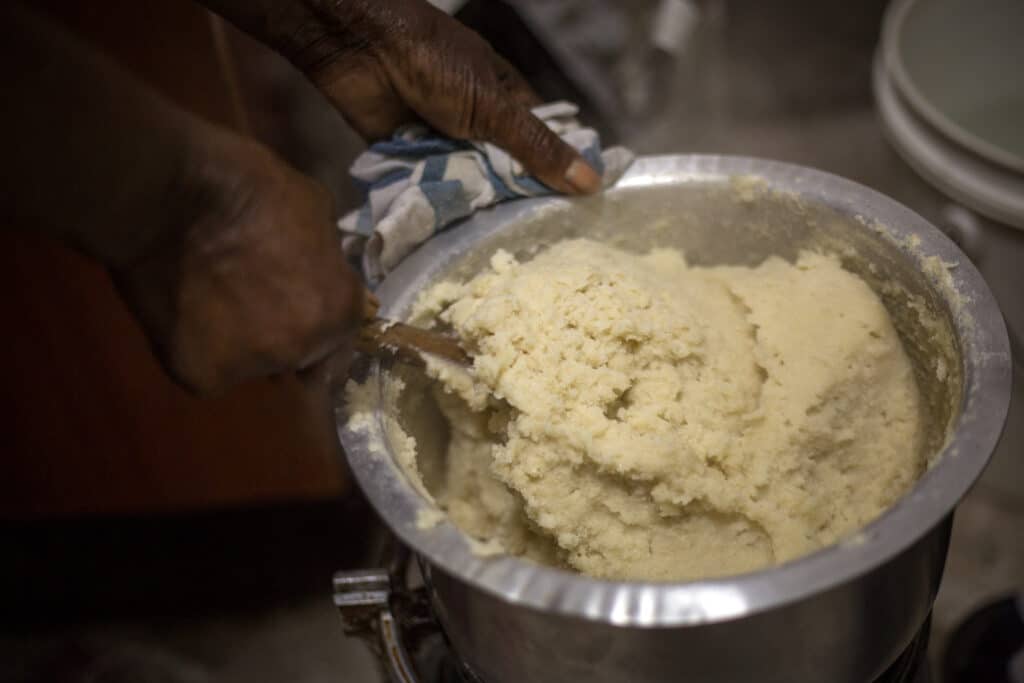
Nsima, a staple food in Malawi, is deeply woven into the fabric of the country’s culture and traditions. This dish, made from cornmeal or maize flour, is not just a source of sustenance but also a symbol of unity and togetherness. Nsima’s influence on Malawian cuisine is profound. Most meals revolve around nsima; it’s often the first meal of the day and the last one before bed.
Our team at Remitly created this guide as part of our series that celebrates the traditional foods of our global customers.
Ingredients and Preparation of Nsima
Preparing nsima requires minimal ingredients—maize flour and water. The maize flour is gradually added to boiling water while stirring continuously until it forms a thick paste. The key lies in achieving the right consistency—neither too hard nor too soft.
Despite its simplicity, making nsima requires skill and practice. It’s often cooked over an open fire in large pots called sufurias. The cooking process can be labor-intensive, but is done with love and care.
Serving and Eating Nsima
Traditionally, nsima is served with relishes—vegetables, beans, meat, or fish stews known as ndiwo or dende in local language. It’s eaten by hand; you roll it into a ball with your right hand, then dip it into the relish.
Eating nsima is more than just a meal—it’s an experience that brings people together. In many households, family members gather around one plate to share this meal—a testament to unity and communal living that characterizes Malawian society.
Variations of Nsima Across Malawi
While the basic recipe of nsima remains the same, variations exist across different regions in Malawi. Some prefer it softer, others harder. The type of maize flour used can also vary—some use finely ground flour while others opt for a coarser variety.
In some parts of Malawi, nsima is made from cassava or sorghum flour instead of maize.
Recipe for Malawian Nsima
Nsima is a simple dish to prepare, requiring only two main ingredients. However, achieving the right consistency and texture requires practice and patience. Here’s a basic recipe to get you started.
Ingredients
- 2 cups of maize flour (cornmeal)
- 4 cups of water
Instructions
- Pour the water into a large pot or sufuria and bring it to boil.
- Slowly add the maize flour while stirring continuously to prevent lumps from forming.
- Continue stirring until the mixture thickens into a smooth paste.
- Reduce heat and cover the pot. Let it simmer for about five minutes.
- Once cooked, scoop out portions of nsima using a wet spoon or ladle and shape them into serving-sized balls or discs.
- Serve hot with your choice of ndiwo—vegetable, bean, meat or fish stew.
Remember, making perfect nsima takes practice—don’t be discouraged if your first few attempts don’t turn out as expected.
Malawian Cuisine: A Rich Tapestry of Flavors
Malawian cuisine is as diverse as its people and geography. It reflects the country’s agricultural heritage, with maize, beans, rice, cassava, potatoes and various fruits forming the backbone of most meals.
Staple Foods in Malawi
Aside from nsima, other staple foods include rice and sweet potatoes—often served with ndiwo like okra curry or pumpkin leaves sautéed with tomatoes and onions.
Beans are another important part of Malawian diet—they’re high in protein and often used in stews along with vegetables like spinach or collard greens.
Meat Dishes in Malawi
Meat dishes are usually reserved for special occasions due to their costliness. Chicken is popular but goat meat is considered a delicacy—it’s often slow-cooked until tender and served with nsima or rice.
Fish is also a significant part of Malawian cuisine, thanks to the country’s numerous lakes and rivers. Chambo, a type of tilapia, is particularly favored—it’s often grilled or fried and served with nsima.
Fruits and Desserts in Malawi
Fruits like mangoes, bananas, guavas and papayas are abundant in Malawi—they’re eaten fresh or used in desserts. A popular dessert is kanyenya—a banana fritter sprinkled with sugar.
Malawian cuisine may not be as globally recognized as some others but it offers a unique blend of flavors that reflect the country’s rich cultural heritage. Whether it’s the humble nsima or a festive goat stew, each dish tells a story about the people and their way of life.
Visit the homepage, download our app, or check out our Help Center to get started.